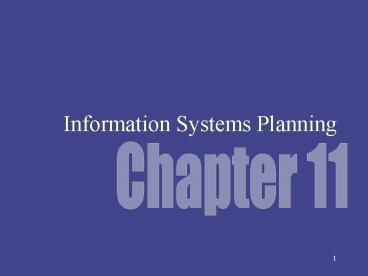Information Systems Planning - PowerPoint PPT Presentation
Title:
Information Systems Planning
Description:
Issue: whether & how extending e-business capabilities ... The IT initiatives must be based on ... Bug fixes. 11. New development, infrastructure, and ... – PowerPoint PPT presentation
Number of Views:15
Avg rating:3.0/5.0
Title: Information Systems Planning
1
Information Systems Planning
2
Opening Case Kmart
- Issue whether how extending e-business
capabilities would revive the companys
competitive position - The IT initiatives must be based on planning
issues - Aligning information systems with business
strategy - Deciding what projects to do, etc.
3
The Process of Information System Planning
4
What Is an Information Systems Plan?
- Information systems planning should be an
integral part of business planning - Business planning the process of identifying
the firms goals, objectives, and priorities
developing action plans for accomplishing them. - Information systems planning the part of
business planning concerned with developing the
firms information systems resources
5
Challenges in Business Planning
- Foreseeing and assessing opportunities
- Assuring consistency with organizational plans
and objectives - Building systems
- Maintaining information system performance
- Collaborating with IT professionals
6
Principles for IS Planning
- Support the firms business strategy with
appropriate technical architecture - Evaluate technology as a component of a larger
system - Recognize life cycle costs, not just acquisition
costs
7
- Design information systems to be maintainable
- Recognize the human side of technology use
- Support and control the technical system
8
Planning Role of the IS and User Departments
- The IS department is responsible for producing
the IS plan in conjunction with the user
departments - Chief information officer (CIO)
- Leads the IS function, and is responsible for
making sure that the IS plan supports the firm's
business plan
9
- User roles in IS planning roles
- Sponsors senior managers who make sure
resources are allocated for building and
maintaining the system - Champions individuals that recognize the
importance of an IS, and exert effort to make
sure that others share that recognition - IS steering committees make sure that the IS
reflects business priorities
10
Allocating Resources Between New and Old ISs
- Maintaining existing ISs and supporting users
- User support projects
- Enhancements
- Bug fixes
11
- New development, infrastructure, and other
projects - Major new applications projects
- IT infrastructure
- Research projects
- Pilot project
12
Project Roles of IT Professionals
- Project managers
- Application programmers
- System analysts
- Programmer-analyst
- Technical writers
- Computer operators
- Database administrators
- System managers
- System programmers
- User support staff
13
Strategic Alignment of Business and IT
14
Figure 11.3
15
Consistency With Business Priorities
- Critical success factors (CSF) the things that
must go right for a business to succeed - Identify the firms primary mission and the
objectives that determine satisfactory overall
performance - Executives identify a relatively small number of
CSFs
16
Reengineering and Downsizing
- Business process reengineering (BPR) the
fundamental rethinking and radical redesign of
business processes to achieve dramatic
improvements in critical measures of performance - Difficult and risky
- Downsizing improve process efficiency by
reducing the number of people involved in the
process
17
Enterprise-wide and Interorganizational Systems
- Interorganizational systems reflect the
customer and supplier aspects of the integration
issues addressed by ERP systems - Integration between ERP packages and supply chain
management - Virtual organizations major aspects of core
processes are outsourced to companies that
specialize in these areas
18
Information System Architecture
- The basic blueprint showing how the firms data
processing systems, networks, and data are
integrated - Must incorporate legacy systems
- Old, and often obsolete systems that are still in
use - Computing platform
- The basic types of computers, operating system,
and network
19
Centralization vs. Decentralization
- Location of hardware and data
- Corporate headquarters
- Regional processing centers
- Site processing centers
- Department processors
- Work group processors
- Individual workstations
20
- Standards, ownership, and guidelines for action
- Position of the IS staff
21
Describing a Business-driven Infrastructure
Figure 11.5
22
Outsourcing
- A long-standing practice in IS departments
- Application service provider (ASP)
- Operate a firms application on remote servers on
a WAN - Advantage the firm no longer needs to install
and maintain the software - Disadvantage the firm has less control over the
application, and may have difficulty transferring
to another ASP if needed
23
International Issues
- Technical incompatibilities
- Social and political issues
- Telecommunication issues
- Transborder data flow
- Economic issues
24
Selecting Systems to Invest In
25
Cost/Benefit Analysis
- The process of evaluating proposed projects by
comparing estimated benefits and costs - Key issues
- Tangible and intangible benefits
- Tendency to understate costs
- Timing of costs and benefits
26
Risks
- Desired benefits are not achieved
- The project is late and/or over budget
- The systems technical performance is inadequate
- User acceptance is low
- Shifting priorities reduce the projects
importance, etc.
27
Financial Comparisons
- Some common criteria used for comparing and
ranking projects - Net present value (NPV)
- Internal rate of return (IRR)
- Payback
28
Project Management Issues
- Division of labor between the IS department and
users - Keeping the project on schedule
- Goals, deliverables, schedules
- Challenges in information system projects
29
Systems Analysis Revisited
30
Information Sources for Analyzing Systems
- Interviews
- Inputs, outputs, and documentation of existing
systems - On-site observation
- Questionnaires
- Benchmarking

